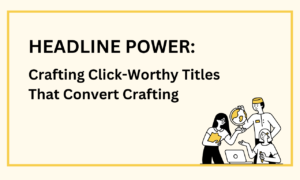Headline Power: Crafting Click-Worthy Titles That Convert Crafting
Headline Power: Crafting Click-Worthy Titles That Convert Crafting
Introduction:
In the age of information overload, attention spans are shorter than ever. This makes headlines the silent heroes of content marketing. A compelling headline can be the difference between your content getting buried or becoming a beacon that attracts readers and drives conversions.
Understanding Your Audience: The Foundation of Captivation
Before you start stringing words together, take a step back and consider your target audience. Who are you writing for? What are their interests, needs, and pain points? Imagine their internal monologue. Are they frustrated with a specific problem? Are they yearning to learn something new that improves their life?
Tailor your headline to resonate with their desires and challenges. For example, if you’re writing about social media marketing for small businesses, a generic headline like “Social Media Marketing Tips” might get lost in the noise. Instead, try a headline that speaks directly to their needs, like “Struggling with Social Media? 5 Powerful Tactics to Boost Your Small Business.”
The Power of Emotion: Headlines that Spark a Feeling
Humans are emotional creatures. Headline that evoke curiosity, fear, excitement, or the desire for a better life have the power to stop a reader in their tracks. Consider:
- Curiosity: A well-crafted question can pique interest and invite engagement. For instance, instead of a flat “The Benefits of Meditation,” try “Can Meditation Really Improve Your Sleep?”
- Fear: Headline that highlight a potential negative consequence can be effective in grabbing attention. For example, “Is Your Website Vulnerable? 3 Security Mistakes Costing You Customers.”
- Excitement: Tap into the desire for positive change or improvement. Think “Unlock Your Creative Potential: 7 Simple Techniques for Writers” or “The Ultimate Guide to Planning Your Dream Vacation.”
However, remember the golden rule: deliver on the promise your headline sets. Don’t overhype and under-deliver, or you’ll lose reader trust.
Intrigue with Questions: Let Readers Ask “Why?”
Questions are powerful tools for sparking curiosity and inviting engagement. Frame a thought-provoking question related to your content to make your audience want to know the answer. This technique works particularly well in list-based headline, such as “5 Signs You’re Eating Too Much Sugar (And What to Do About It!)”
Numbers & Lists: Simplicity Wins
People are drawn to the simplicity and scannability of lists. Headline with numbers or that promise a specific number of tips or tricks can be highly effective. For example, “10 Must-Have Plugins for Your WordPress Blog” or “7 Hacks to Master Your Time Management.” Numbers create a sense of clarity and value, letting readers know exactly what they’ll gain from engaging.
Clarity & Concision: Keep it Clear, Keep it Short
Your headline should be a crystal-clear window into your content. While you might be tempted to pack in every keyword and benefit, prioritize clarity over a vocabulary showcase. Avoid jargon and complex phrasing. Aim for easy comprehension, even for someone skimming headline quickly.
Here’s an example: Instead of “The Intricacies of Utilizing Effective Website Optimization Techniques to Enhance Brand Recognition,” opt for a simpler, more direct approach like “SEO Made Simple: Boost Your Website Traffic Today.”
strong Verbs & Action Words: Words that Motivate
Headline don’t have to be passive. Use powerful verbs that create a sense of urgency or inspire action. This will make your headline more dynamic and engaging.
For example, instead of “The Importance of Building an Email List,” try a more action-oriented approach like “Grow Your Business: Start Building a Powerful Email List Now!” This slight shift makes the headline more compelling and sparks reader interest.
SEO Optimization: Headlines with Search Engine Savvy
Don’t forget the power of search engines! Including relevant keywords in your headline can improve your content’s organic reach. This means more people will see your content in search results, leading to potential new readers.
However, prioritize clarity over keyword stuffing. A search engine might love a headline like “Increase Website Traffic, Conversions, and Customer Engagement Strategies SEO Techniques,” but humans will likely find it clunky and off-putting.
Beyond the Basics: Refining Your Headline Craft
Crafting compelling headlines is a skill that takes practice and experimentation. Here are some additional tips to help you become a headline master:
Test & Refine:
A/B testing allows you to see which headlines resonate best with your audience. Create multiple versions of your headline and use website analytics or social media insights to track click-through rates. This data-driven approach can help you continually improve your headline crafting skills.
Avoid Clickbait:
Resist the urge to mislead readers with sensational headlines that don’t deliver on their promises. Clickbait might get a temporary click, but it erodes trust and damages your reputation in the long run.
Social Media Savvy:
Tailor your headline for the specific platform where your content will be shared. Keep it short and punchy for social media snippets. For example, a headline for a blog post might be “The Ultimate Guide to Headline Writing,” but for a captivating Twitter post, you might shorten it to “Headline Hacks: Write Titles That Get Clicks.”
Promise & Payoff:
Make sure your headline accurately reflects the content but also entices readers with a clear benefit. They should understand what they’ll gain by clicking.
Urgency & Scarcity:
Headline that create a sense of urgency or tap into the fear of missing out (FOMO) can be effective. For instance, “Limited Time Offer: Download Our Free Marketing Toolkit!” or “Last Chance to Register for the Webinar!” However, use these tactics sparingly to avoid appearing manipulative.
Specificity Matters:
While intrigue is important, avoid overly vague headline. Specificity piques interest and lets readers know exactly what your content is about. For example, instead of “Healthy Living Tips,” try “5 Easy Meal Prep Hacks for Busy Weeknights.”
Headline Formulas:
- Provide a few tried-and-tested headline formulas that can be easily adapted to different content types.
- For example, the “Number + Benefit” formula (e.g., “5 Hacks to Master Your Time Management”) or the “Question + Intrigue” formula (e.g., “Can Meditation Really Improve Your Sleep?”).
Common Headline Mistakes:
- Discuss some common headline mistakes to avoid, such as clickbait tactics, keyword stuffing, or overly generic titles. Offer suggestions on how to improve these types of headline.
Headline Examples:
- Showcase strong and weak headline examples throughout your article. Analyze what makes a good headline effective and a weak one fall flat.
Headline Tools & Resources:
- Consider including a section with helpful tools and resources for crafting headline. This could include online headline generators, swipe files with successful headline, or website analytics tools for tracking click-through rates.
Call to Action:
- End your article with a strong call to action (CTA). Encourage readers to put their newfound headline knowledge into practice by crafting click-worthy titles for their own content.
Conclusion:
In the ever-growing sea of content, a captivating headline is your life raft, pulling readers in and saving your content from obscurity. This guide has equipped you with the tools and strategies to craft click-worthy titles that resonate with your audience and achieve your content marketing goals. Remember, the art of headline writing is a continuous learning process. Experiment, test, analyze, and refine your approach to create headline that are as irresistible as they are informative.
So, unleash your inner headline maestro! Go forth and captivate your audience with titles that command attention and convert clicks into loyal readers and thriving content.
click to see another interesting blog.
FAQ:
What is the 80-20 rule of headlines?
According to the 80-20 rule, most people, around 80 percent, will read the headline of a piece of content, but only a smaller fraction, about 20 percent, will continue reading beyond that point.
This rule highlights the importance of crafting a powerful and captivating headline that effectively conveys the main message or value of the content. A compelling headline increases the likelihood of engaging more than just 20 percent of readers and encouraging them to explore the rest of the content.
What should you avoid when writing a headline?
To create effective headlines, it is essential to use clear and straightforward language that avoids complexity and confusion. Ensure that your headline accurately reflects the content it accompanies. Avoid using vague language and instead focus on delivering a concise and direct message in your headline.


